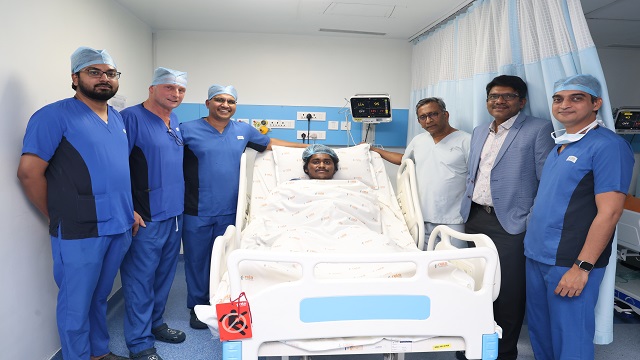Rela Hospital Becomes First in Tamil Nadu to Use Synthetic Ligament for Treating Knee Injury
In a staged intervention, surgeons at Rela Hospital first stabilised the patient’s fractured pelvic region with external fixation and repaired a few other damaged ligaments and nerves in the knee. After a gap of three months, they performed an hour-long arthroscopy procedure today using synthetic ligaments, imported from the United Kingdom, and successfully reconstructed the two cruciate ligaments – namely, anterior cruciate ligament (ACL) and posterior cruciate ligament (PCL). This advanced procedure marks a significant milestone in the treatment of complex knee injuries in Tamil Nadu.
ACL and PCL are the knee’s primary ligaments. They join thigh bones to the bones of the lower leg. Injuries to two or more of these primary ligaments are called multi-ligament knee injuries. These injuries are often associated with high-energy trauma, such as road accidents or sports injuries. Patients with multi-ligament knee injuries face a high risk of long-term morbidity, including chronic pain, instability, and impaired mobility.
Dr. Ilankumaran Kaliamoorthy, CEO, Rela Hospital said, “Surgeons traditionally use either autograft, which involves harvesting and using ligaments of the patient’s own body, or allograft, wherein ligaments of the cadaver or amputated legs. These treatment approaches can lead to prolonged rehabilitation periods and incomplete recovery, affecting the patient’s quality of life and ability to return to work or sports. However, synthetic ligaments have come as a boon for patients with multi ligament injuries as they eliminate many of the shortcomings of the traditional methods.”
The arthroscopy procedure was performed by Dr. Prakash Ayyadurai, Senior Consultant Arthroscopy & Sports Medicine of Rela Hospital, and his team in the presence of Dr. Ashok S. Gavaskar, Clinical Lead – Orthopaedics, Head of Joint Replacement Services, Rela Hospital and Dr. Parthasarathy Srinivasan, Senior Consultant – Orthopaedics, Head – Spine Surgery, Rela Hospital. The surgery went eventless, and the patient is expected to be discharged from the hospital within a week’s time. He can take up his routine activities without any restrictions, forgetting his painful and complex injury as a bad dream.
In his comments, Dr. Ayyadurai said, “Though arthroscopy surgery is not new, it is for the first time this minimally-invasive procedure was performed using synthetic ligaments, which have come as a viable and preferred alternative for both autograft and allograft. The traditional methods of autograft and allograft have their own disadvantages. In autograft, an additional surgery has to be performed to harvest ligament from the patient’s own body. The risks include infection and other complications, besides the likelihood of reduced function and a permanent discomfort at the donor’s site. Similarly, in the case of allograft, there is a waiting period. Ligaments are difficult to procure in India as the availability is limited. There are also regulatory challenges. However, synthetic ligaments are readily available. They do not require regulatory approvals. Best of all, the recovery and rehabilitation time for the patient is in days, instead of weeks or months as is the case with procedures based on autograft and allograft.
Dr. Klaudiusz Kosowski, Medical Director and Chairman, MedPolonia Private Hospital, Poland pointed out that the synthetic ligaments are made of a strong polythene material and are on par with the natural ligaments in terms of strength and durability. “Considering that about 15-20% of all knee injuries are multiligament knee injuries that require reconstruction of ligaments, synthetic ligaments can be a game changer in arthroscopy.”

